You will often see both linear and quadratic functions in science and math courses. However, it is helpful to see the differences between them compared side-by-side.
So, what is the difference between linear and quadratic functions? A linear function is graphed as a line, has a constant slope, and increases by a constant amount in each time interval. A quadratic function is graphed as a parabola, changes the sign of its slope at the vertex, and has differences that increase by a constant amount in each time interval.
Of course, the function you use depends on what you are trying to model. For example, linear functions are useful for distance at a constant speed, while quadratic functions are useful for acceleration due to gravity.
In this article, we’ll talk about the differences between linear and quadratic functions. We’ll also answer some common questions and look at examples to make the concepts clear.
Let’s get started.
What Is The Difference Between Linear & Quadratic Functions? (Linear vs Quadratic Functions)
The key difference between linear and quadratic functions is the slope (first derivative) of the curves (that is, the rate of change over time):
- A linear function has a constant slope (and a zero second derivative).
- A quadratic function has a slope that is always changing (and a constant, nonzero second derivative).
Another way of saying this is that the second differences (second derivative) of a linear function is zero, while the second differences of a quadratic function are constant (but never zero).
On a graph, a linear function is a straight line of the form y = mx + b, as shown below.

On the other hand, a quadratic function is a parabola of the form y = ax2 + bx + c, like the one shown below.
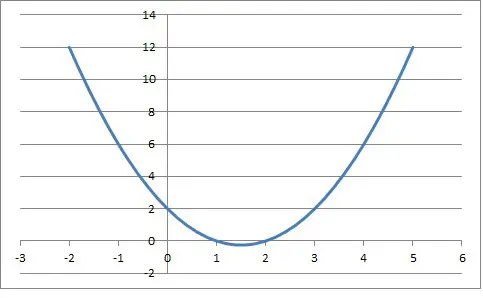
The parabola’s concavity may be either:
- concave (when a < 0, meaning the second derivative is negative)
- convex (when a > 0, meaning the second derivative is positive)
A linear function increases by a constant amount (the value of its slope) in each time interval, while a quadratic function increases by a different amount in each time interval.
For example:
- The linear function f(x) = 2x increases by 2 (a constant slope) every time x increases by 1.
- The quadratic function g(x) = x2 increases by 1 from x = 0 to x = 1, by 3 from x = 1 to x = 2, by 5 from x = 2 to x = 3, etc.
The following table shows the differences between linear and quadratic functions at a glance.
| Function Type | Linear | Quadratic |
|---|---|---|
| Slope (1st difference) | constant | linear |
| Concavity 2nd difference) | zero | constant (nonzero) |
| Equation | ax + b a = slope b = y intercept | ax2 + bx + c a tells us the concavity; c tells us the y-intercept |
| Table | look for y values that increase by a constant value | look for first differences of y values that increase by a constant amount |
| Graph | line | parabola |
| Phrases in a word problem | constant slope; constant speed; constant rate of change | constant second differences; constant acceleration |
and quadratic functions at a glance.
How Do You Know If An Equation Is Linear Or Quadratic?
To tell if an equation is linear or quadratic, remember the form of each one:
- A linear equation has the form f(x) = ax + b. [a is the slope, and b is the y-intercept]
- A quadratic equation has the form g(x) = ax2 + bx + c. [The value of a is the coefficient of the quadratic term and also the second derivative, which tells us the concavity: whether the graph of the parabola opens up or down. The value of b is the coefficient of the linear term. The value of c is the constant term and also the y-intercept of the parabola.]
If there is no quadratic term (that is, the value of a is zero), then the equation is not quadratic.
If there is any power of x other than 1 (linear term) or 0 (constant term), then the equation is not linear.
Example 1: A Linear Equation
Consider the equation f(x) = 2x + 5.
This equation is linear since it has the form ax + b (a = 2 is the slope, and b = 5 is the y-intercept).
Note that there is no quadratic term (there is no term with an x2].
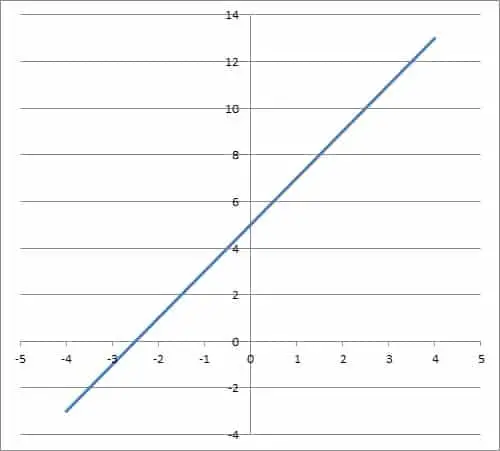
Example 2: A Quadratic Equation
Consider the equation f(x) = 2x2 – 12x + 16
This equation is quadratic since it has the form ax2 + bx + c (a = 2, b = -12, c = 16).
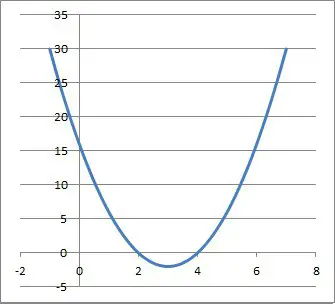
Example 3: An Equation That Is Neither Linear Nor Quadratic
Consider the equation f(x) = x3.
This equation is not linear, since it has a cubic term (x3). Thus, it does not have the form ax + b, which is required for a linear equation.
This equation is not quadratic, since there is a cubic term (x3). Thus, it does not have the form ax2 + bx + c, which is required for a quadratic function.
In fact, this is a cubic function. It has the graph pictured below.
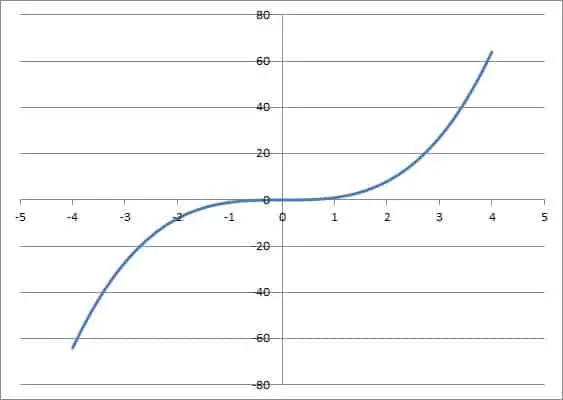
How Do You Know If A Table Is Linear Or Quadratic?
To tell if a table of x and y values represents a linear or quadratic function, add some columns to the table:
- First differences of x
- First differences of y
- Slope – that is, the ratio of: (first differences of y) / (first differences of x)
Now, examine the entries in the slope and concavity columns to determine they type of function that the data represents:
- If the entries in the slope column are constant, then the data in the table represents a linear function.
- If the entries in the slope column increase by the same value each time, then the data in the table represents a quadratic function.
- If neither of these is true, then the data in the table represents some other type of function.
Example 1: Table Of Values For A Linear Function
Consider the following table of values:
| x | y |
|---|---|
| 0 | 2 |
| 1 | 5 |
| 2 | 8 |
| 3 | 11 |
| 4 | 14 |
| 5 | 17 |
| 6 | 20 |
| 7 | 23 |
We can add 3 columns to the table: first differences of x, first differences of y, and slope – that is, the ratio of (first differences of y) / (first differences of x):
| x | y | First Differences of x | First Differences of y | Slope |
|---|---|---|---|---|
| 0 | 2 | |||
| 1 | 5 | 1 | 3 | 3/1 = 3 |
| 2 | 8 | 1 | 3 | 3/1 = 3 |
| 3 | 11 | 1 | 3 | 3/1 = 3 |
| 4 | 14 | 1 | 3 | 3/1 = 3 |
| 5 | 17 | 1 | 3 | 3/1 = 3 |
| 6 | 20 | 1 | 3 | 3/1 = 3 |
| 7 | 23 | 1 | 3 | 3/1 = 3 |
Since all of the slopes are the same, we know that we have a constant function. In fact, its equation is y = 3x + 2.
Example 2: Table Of Values For A Quadratic Function
Consider the following table of values:
| x | y |
|---|---|
| 0 | 1 |
| 2 | 5 |
| 4 | 17 |
| 6 | 37 |
| 8 | 65 |
| 10 | 101 |
| 12 | 145 |
| 14 | 197 |
We can add 3 columns to the table: first differences of x, first differences of y, and slope – that is, the ratio of (first differences of y) / (first differences of x):
| x | y | First Differences of x | First Differences of y | Slope |
|---|---|---|---|---|
| 0 | 1 | |||
| 2 | 5 | 2 | 4 | 2 |
| 4 | 17 | 2 | 12 | 6 |
| 6 | 37 | 2 | 20 | 10 |
| 8 | 65 | 2 | 28 | 14 |
| 10 | 101 | 2 | 36 | 18 |
| 12 | 145 | 2 | 44 | 22 |
| 14 | 197 | 2 | 52 | 26 |
Since the slope increases by the same amount (plus 4) each time, we know that we have a quadratic function. In fact, its equation is y = x2 + 1.
Example 3: Table Of Values For An Exponential Function
Consider the following table of values:
| x | x |
|---|---|
| 0 | 5 |
| 1 | 10 |
| 2 | 20 |
| 3 | 40 |
| 4 | 80 |
| 5 | 160 |
| 6 | 320 |
We can add 3 columns to the table: first differences of x, first differences of y, and slope – that is, the ratio of (first differences of y) / (first differences of x):
| x | y | First Differences of x | First Differences of y | Slope |
|---|---|---|---|---|
| 0 | 5 | |||
| 1 | 10 | 1 | 5 | 5 |
| 2 | 20 | 1 | 10 | 10 |
| 3 | 40 | 1 | 20 | 20 |
| 4 | 80 | 1 | 40 | 40 |
| 5 | 160 | 1 | 80 | 80 |
| 6 | 320 | 1 | 160 | 160 |
Since the slope increases by the same ratio (times 2) each time, we know that we have an exponential function. In fact, its equation is y = 5*2x.
So, this table is neither linear nor quadratic.
How Do You Know If A Graph Is Linear Or Quadratic?
A graph is linear if it has a constant slope (it always increases at the same rate). The graph is a straight line, and it can also be horizontal (y = b, zero slope) or vertical (x = a, undefined slope).
The graph below is a linear function.
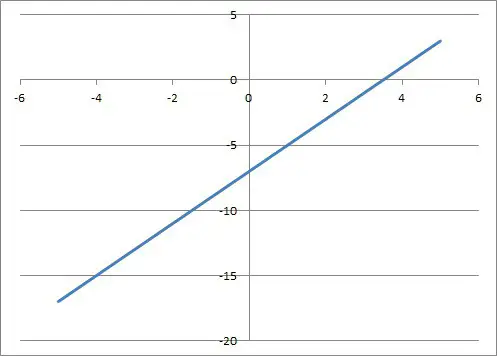
A graph is from a quadratic function if it has the shape of a parabola, with a vertex (highest or lowest point). The absolute value of the slope gets larger as x gets larger.
The graph below is a quadratic function.
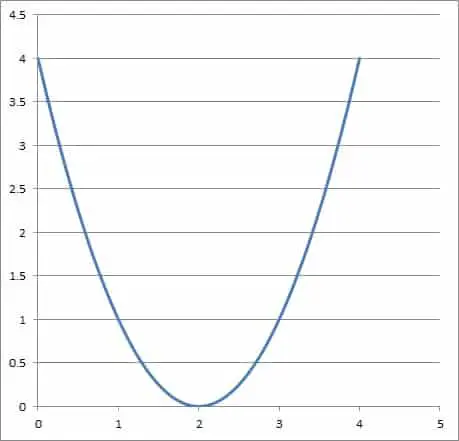
How Do You Know If A Word Problem Is Linear Or Quadratic?
You can tell if a word problem is linear or quadratic by paying close attention to the key phrases.
If a word problem mentions that a quantity increases by the same amount (or a constant amount) in every time interval, then use a linear function to model the problem.
Some other phrases that suggest linear functions are:
- constant slope
- constant rate of change
- constant speed
If a word problem mentions that a quantity increases by an increasing amount in every time interval, and the second differences are constant, then use a quadratic function to model the problem.
Some other phrases that suggest quadratic functions are:
- constant second difference
- constant acceleration
Example 1: Linear Function Word Problem
Let’s say that we start at 10 miles north of Boston, and we are driving north at a constant speed of 60 miles per hour. Write a function to tell us how far north of Boston we are after H hours.
Since our speed is constant (60 miles per hour), this implies a constant slope, so we will use a linear function to model the situation.
For a linear function, we have the equation
- D = aH + b
where a is the slope (speed) and b is the y intercept (starting distance north of Boston.) D is the distance north of Boston after H hours, and H is the time that has passed in hours.
We know that the speed of 60 miles per hour represents our sloe, so a = 60. This gives us:
- D = 60H + b
Now we just need to find the value of b. Remember that we started at a distance of D = 10 miles north of Boston (at time H = 0), which gives us:
- 10 = 60(0) + b [D = 10, H = 0]
- 10 = b
So, we can write the full linear equation:
- D = 60H + 10
So after 5 hours, we will be a distance of D = 60(5) + 10 = 310 miles north of Boston.
Example 2: Quadratic Function Word Problem
Let’s say that a falling object has a constant acceleration of 32 feet per second. It is dropped from rest at a starting height of 144 feet.
Since the acceleration is -32 feet per second (negative due to falling), the velocity is 0 – 32t (0 because the starting velocity is zero, since the object was dropped from rest).
Since the velocity is -32t, the height is 144 – 32t2/2 = 144 – 16t2 (144 comes from the starting height of 144 feet).
So, the object will hit the ground when the height is zero, or:
- 144 – 16t2 = 0
- 144 = 16t2
- 144/16 = t2
- 9 = t2
- 3 = t (since time should be positive)
At t = 3 seconds, the dropped object will hit the ground.
Conclusion
Now you know the difference between linear and quadratic functions. You also know the answers to some common questions about how to tell them apart.
If you want to know more about lines and slopes, you can learn about when lines are parallel in my article here.
You can learn about the difference between quadratic and exponential functions here.
You can also learn about the difference between linear and exponential functions here.
I hope you found this article helpful. If so, please share it with someone who can use the information.
Don’t forget to subscribe to my YouTube channel & get updates on new math videos!
~Jonathon

